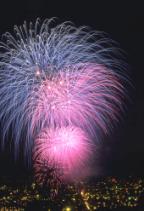 by Preston MacDougall July 03, 2005
Although it was the Chinese who invented fireworks, eons ago, many Western countries now have at least one day on their calendar that children refer to as "firecracker day."
When I was growing up in Canada, firecracker day was May 24th. The grown-ups called it "victorious day", but I had no idea who had beaten whom. I recall one year in particular, this was in the sixties, before Trudeau and stepped-up gun control, when my Dad and a few other fathers in our Toronto neighborhood decided that sparklers and single-color Roman candles weren't exciting enough for "victorious day." They pooled their money and bought a single rocket that I recall being launched by what looked like a bazooka. Unfortunately, it went screaming off course and landed behind some trees, so I never got to see the colorful display that we had been anticipating for weeks. I still had my sparkler though, and once again enjoyed watching the rain of smoking white-hot products from the combustion reaction between flecks of magnesium and the oxygen in the air. Later I learned that the name of the holiday was Victoria Day, and we were celebrating the birthday of England's Queen Victoria. She was long dead and known for lending her name to those cute gingerbread houses still found in ritzy neighborhoods. I'm not sure of the connection to fireworks, however. Even later I learned the fate of the fizzled rocket. Good thing the owner of the impacted house had a sense of humor. Nobody was injured and damage was minimal. Not being a monarchist myself, if I still lived in Canada I imagine that May 24th would be renamed Victoria's Secret Day around my house, and the fireworks would be based on a completely different kind of chemistry. In the United Kingdom, fireworks figure both in the celebration of Guy Fawkes Day, and the event that is commemorated every November 5. Today, we would call Guy Fawkes a terrorist, as he had attempted to blow up the British Houses of Parliament in 1605, just as the first King James was calling the Lords and Commons to order. In a cellar directly below parliament, Fawkes had laid iron bars over 36 barrels of gunpowder. (Incidentally, these are the basic chemical ingredients of the fireworks yielding the ever-popular golden starburst.) In a case of accurate military intelligence concerning "weapons of mass destruction," his plot was foiled and he was caught upon entering the cellar to light the fuse. I wonder how many young children in England these days know that Guy Fawkes was a "bad guy", or that the fireworks are in celebration of his capture? I imagine that some are as blissfully clueless as I was, perhaps thinking that they are celebrating a clever "gray fox," who must have famously outwitted a pack of slobbering hounds. On July 4th, it is of course the independence from Kings and Queens that we celebrate in the United States. And we do so with pyrotechnical gusto. It's a natural fit, even if they are made in China. Just listen to the words of our national anthem: "And the rocket's red glare, the bombs bursting in air, gave proof through the night that our flag was still there." In any celebration worth its salt, there will be bombs bursting with every color of the rainbow and more, such as gold, which, the Irish say, is at the end of end it. In most cases, the color in a pyrotechnic device does in fact come from a salt. For instance, barium-containing salts, similar to those you may have swallowed, or taken in at the other end, prior to a gastro-intestinal X-ray, are embedded along with an explosive mixture to give a bright green starburst. Immediately above barium on the periodic table, strontium is the key ingredient for the bright reds in a pyrotechnician's palette. In its elemental form, there would be a high danger of premature explosion, so salts, such as strontium carbonate are blended instead. For the blues, take copper salts. As my freshman chemistry students learn doing flame tests on their Bunsen burners, potassium salts give off a beautiful lavender color, but it is too weak to wow republican revelers. Instead, a mixture of strontium and copper salts (red and blue) gives a powerfully purple starburst. I expect that each country has its share of traditionalists, who will try, valiantly or in vain, to instill a proper sense of respect for the true meaning of the corresponding holiday. Just as there are bound to be pyrotechnic wholesalers who will try to convince children, and city council members, that every day should be firecracker day. For me, whatever the occasion, a grand fireworks display is an opportunity to talk chemistry. Or, if no one is in the mood for a lecture, to just sit back, and watch it happen.
|
||
